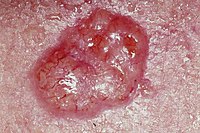
Photo from wikipedia
ABSTRACT Purpose/Objectives: Overall non-melanoma head and neck skin cancer has a good prognosis; however, rarely patients have an aggressive variant which results in orbital invasion via perineural spread or direct… Click to show full abstract
ABSTRACT Purpose/Objectives: Overall non-melanoma head and neck skin cancer has a good prognosis; however, rarely patients have an aggressive variant which results in orbital invasion via perineural spread or direct extension. Despite these consequences, there are limited published studies defining this clinical entity. The main objectives of the current study are to describe orbital invasion patterns of non-melanoma head and neck skin cancers and their impact on survival. Methods: Retrospective case series from a tertiary-care, academic institution performed between 2004 and 2014. Demographic and tumour characteristics are reported as well as patterns of orbital invasion, types of treatments received, and survival outcomes. Results: There were 17 consecutive patients with non-melanoma skin cancer and orbital invasion who met inclusion criteria. Average age at orbital invasion diagnosis was 70.8 years old. 76% were male. Mean follow-up time was 28.5 months. Of these patients, 71% had squamous cell carcinoma and 29% had basal cell carcinoma. Brow (41%) was the most common primary sub-site followed by cheek (23%) and temple (12%). 76% of patients had a history of prior treatment. The lateral orbital wall (41%) was the most common site of invasion, followed by the medial orbital wall (29%) and antero-superior invasion (23%). Age, histology, and location of orbital invasion were associated with disease-specific and overall survival. Conclusion: Orbital invasion for non-melanoma head and neck skin cancers creates a treatment dilemma and the patterns of invasion are described. In addition, the location of orbital invasion is associated with survival outcomes.
Journal Title: Orbit
Year Published: 2018
Link to full text (if available)
Share on Social Media: Sign Up to like & get
recommendations!